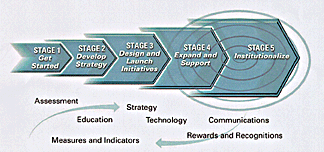Why Implementing KM is like Raising a Child
Last week, I was observing a communication session whereby a group of senior managers were updated on the progress of KM in their organization. When we got to the part on their KM roadmap, someone asked where the organization was on the roadmap (I can’t replicate their roadmap here but it looks quite similar to APQC’s KM Roadmap below). The replies were as varied as the number of stages, and each contrasting view was defended vigorously. It was a lively debate as ever there was.

It should come as no surprise that no consensus was reached, but why? I think that it’s because while KM roadmaps are usually linear from start to finish, actual KM implementation is far from so. It’s more like snake-and-ladder, where you sometimes have to go back a few steps before you can move forward.
It’s also like raising a child. There is a rough roadmap that parents follow – teach the kid basic survival skills; send the kid to kindergarten, primary school, secondary school, then university. Hopefully, at the end of all that effort, the kid will become a productive member of society. There is a logical progression to this broad roadmap, but wait. Just because a kid has entered into kindergarten doesn’t mean that he’s ready for it. Just because an undergrad has entered into university doesn’t mean that he’s mastered everything up to that point. Regardless whether the ground before is well covered or not, you push the kid through the stages, and hopefully he will catch up somehow along the way (tuition perhaps).
Similarly, just because an organization has reached the later stages of a KM roadmap doesn’t mean that the grounds before are well covered. In many cases, some parts of the roadmap have to be redone or improved. This doesn’t mean that the entire KM effort has become stationary. No. Just like the parental roadmap, a KM team continues to push the roadmap through to its later stages while continuing work on earlier stages. This is why the senior managers I observed last week had conflicting perceptions of where their organization was on their KM roadmap. Depending on where you stand, you see different level of work done. The job of the KM Team is hence to make sure that the organization gets to the end of the KM journey, so that KM will become a valuable contributor to business success.
3 Comments so far
- Edgar Tan
I agree with you, Siew Ning, that there is no end to the KM journey. What I should have said was, “the end of the KM roadmap”. But even then, when you get to the last stage of the KM roadmap, you may find yourself having to revisit the earlier stages, eg, roll out, test and refine new initiatives. The iterative nature of KM implementation is the gist of my post.
I would rather take it from the angle of maturity of KM within the organization. As you progress your journey to achieve the desired objectives in your roadmap, surely you will be doing few things better than others. And it is always about fine tuning on some aspects to make it better. So roadmap is one piece of strategic direction which is set as a plan, and maturity is probably a measurement of how well you are addressing your roadmap. Re-visit is a continuous effort. Even if you performed very well then it’s time to raise the standard, again it-s about a continuous re-visit of your roadmap.The journey will never end, but we are still able to reach the ‘end state’ as defined and move on further from there.
Page 1 of 1 pages
Comment Guidelines: Basic XHTML is allowed (<strong>, <em>, <a>) Line breaks and paragraphs are automatically generated. URLs are automatically converted into links.

Edgar,
I agree in general with your ocmments except for the part on “The job of the KM Team is hence to make sure that the organization gets to the end of the KM journey, so that KM will become a valuable contributor to business success.”
There is never an “end of the KM journey” for a living organization. If that happens, it means that the organization has ceased to exist.
Posted on June 08, 2008 at 01:52 AM | Comment permalink